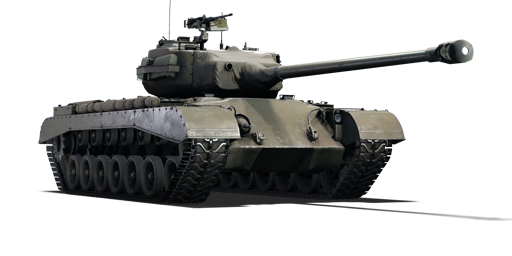



The T32 is a American heavy tank. It was one of the first American tanks to be released with the American ground tree in Update 1.45 "Steel Generals". It can be seen as an extremely buffed up version of a M26 Pershing with a high velocity 90 mm gun and extremely tough front turret armour able to exploit hull down positions against its competitors.
The T32 is a post-World War II heavy tank with 7.3 Battle Rating, and it's one of the best tanks for a specific battle tactic known as hull-down. Due to its 298 mm thick frontal turret armour, it will mostly deflect any incoming armour-piercing shells at any range, except incoming High-Explosive Anti-Tank Fin-Stabilized (HEATFS), aimed at the turret hole beneath the mantlet. It's crucial to conceal the T32's weak spots, especially the lower plate tips and lower mantlet since both spots can cause catastrophic damage to the T32.
Even if a T32 is hull-down, doesn't mean it's invulnerable. If an armour-piercing shot deflects at the lower mantlet and penetrates through top hull armour, It will instantly knock out the tank, since the deflected shot goes right through the main ammo load and blows it off. Also, a very powerful HE shot from guns with over 120 mm calibre can cause severe damage to the T32's armour.
It's armed with the 90 mm T15E2 gun, and very effective against most enemies appearing in its Battle Rating range, mainly with late-World War II German and Soviet tanks. The stock ammunition T43 Armoured Piercing shell has good penetration but lack of explosive warhead is not enough to knock out most tanks in a single shot. A concentrated shot has to be very well aimed to seriously damage any enemy. Like most of U.S. tanks, the T32 performs better when armed with newly researched shell, the T41 Armour-Piercing Capped Ballistic Cap. Thus, the ammunition upgrades are very advisable to research first. The T41 shell has the roughly equal penetrating power with the T43 shell but contains 140 grams of explosive warhead inside, deadly enough to destroy any kind of tank in a single successful penetrating shot. Other shell includes T44 Armour-Piercing Composite Rigid, with impressively better penetration but unarmed with explosives. Despite having no explosive at all, APCR is good enough to cook off enemy tank's ammo load or take out critical module parts with an accurate shot. There's also T42 High Explosive shell, which is useful for destroying Self-Propelled Anti-Air vehicles, but rather ineffective against armoured vehicles.
| Ammunition | Type | Armor penetration (mm) at a distance: | |||||
|---|---|---|---|---|---|---|---|
| 10 m | 100 m | 500 m | 1000 m | 1500 m | 2000 m | ||
| APBC | 211 | 208 | 193 | 177 | 162 | 148 | |
| HE | 26 | 25 | 24 | 22 | 20 | 18 | |
| APCBC | 224 | 221 | 209 | 195 | 181 | 169 | |
| APCR | 336 | 330 | 304 | 274 | 248 | 223 | |
| Belt | Belt filling | Armor penetration (mm) at a distance: | |||||
|---|---|---|---|---|---|---|---|
| 10 m | 100 m | 500 m | 1000 m | 1500 m | 2000 m | ||
| API-T/I/AP/API-T | 31 | 29 | 21 | 14 | 9 | 6 | |
| Belt | Belt filling | Armor penetration (mm) at a distance: | |||||
|---|---|---|---|---|---|---|---|
| 10 m | 100 m | 500 m | 1000 m | 1500 m | 2000 m | ||
| AP/T | 13 | 12 | 7 | 3 | 2 | 0 | |












Mobility | |
|---|---|
Protection |
|---|
Firepower | |
|---|---|